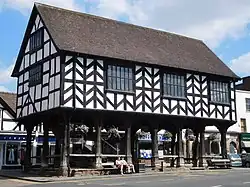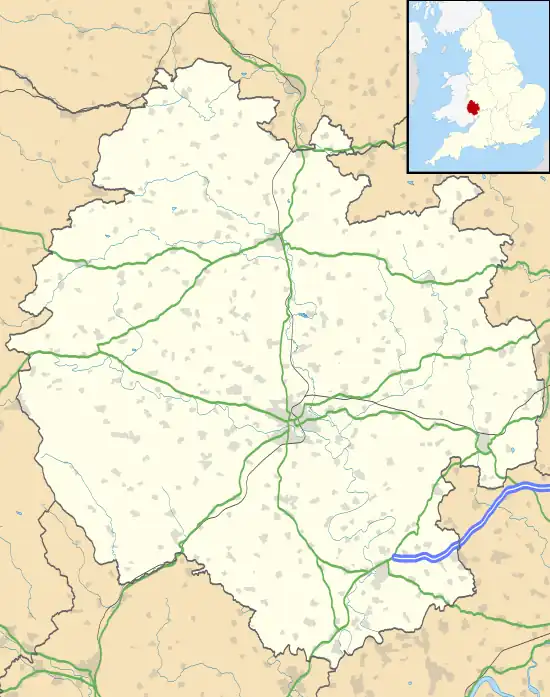| Ledbury Market Hall | |
|---|---|
 Ledbury Market Hall | |
| Location | High Street, Ledbury |
| Coordinates | 52°02′13″N 2°25′22″W / 52.0370°N 2.4227°W |
| Built | 1617 |
| Architect | John Abel |
| Architectural style(s) | Tudor style |
Listed Building – Grade I | |
| Official name | Market House, High Street |
| Designated | 18 September 1953 |
| Reference no. | 1349392 |
 Shown in Herefordshire | |
Ledbury Market Hall, also known as Ledbury Town Hall,[1] is a municipal building in the High Street in Ledbury, Herefordshire, England. The structure, which is used as an events venue, is a Grade I listed building.[2]
History
In the early 17th century, a market trader, John Phillips, launched an initiative to demolish an existing row of buildings in Shoppe Row and erect a market hall in their place.[3] The building, which has been attributed to the master mason, John Abel, was designed in the Tudor style using half-timbered construction and was completed in 1617.[4][5][6] The design involved a symmetrical main frontage with seven bays facing onto the High Street; the building was open on the ground floor, so that markets could be held, with a storeroom for grain on the first floor. The first floor, which was jettied out over the pavement, was supported by 16 oak posts and was accessed by a wooden staircase at the north end of the building.[7] The first floor was fenestrated, on the west side, by three six-light mullioned and transomed windows and the half-timbering was executed in a Herringbone pattern.[2]
The Royalists defeated the Roundheads in a minor skirmish in the Market Place in April 1645 during the English Civil War.[8] The store room on the first floor was converted for civic use in the early 19th century,[9] enabling it to be used as a town hall and also as a venue for theatrical performances: early performers included the actor, Ira Aldridge, who appeared in a series of melodramas in late January and early February 1831.[10]
Queen Elizabeth II, accompanied by the Duke of Edinburgh, visited the building during a tour of the county in April 1957.[11][12] The building continued to be used for meetings of Ledbury Town Council and wedding ceremonies until 2004 when these uses were discontinued because of the lack of disabled access.[13] An extensive programme of restoration works, which involved temporarily raising the building by 600 millimetres (24 in) so that the oak posts could be restored, was completed in 2006.[14]
See also
References
- ↑ "Ledbury Town Hall". Vol. 24. The Builder. 18 August 1866. Retrieved 30 January 2022.
- 1 2 Historic England. "Market House, High Street (1349392)". National Heritage List for England. Retrieved 30 January 2022.
- ↑ Freeman, Marion (2009). Ancient Crosses of the Three Choirs Counties. History Press. ISBN 978-0750952675.
- ↑ "Science reveals age of Ledbury's Market House". Ledbury Reporter. 12 December 2008. Retrieved 30 January 2022.
- ↑ Howard, Maurice (2007). The building of Elizabethan and Jacobean England. The Paul Mellon Centre for Studies in British Art. p. 76. ISBN 978-0300135435.
- ↑ Hayman, Richard (2021). Timber-Framed Buildings. Bloomsbury. p. 51. ISBN 978-1784424282.
- ↑ "'Ledbury', in An Inventory of the Historical Monuments in Herefordshire, Volume 2, East". London: British History Online. 1932. pp. 100–114. Retrieved 31 January 2022.
- ↑ "Blood on the streets as war hits Ledbury". Worcester News. 7 September 2001. Retrieved 30 January 2022.
- ↑ Lever, Michael (2013). Ledbury Through Time. Amberley Publishing. p. 132. ISBN 978-1445615486.
- ↑ Lindfors, Bernth (2011). Ira Aldridge Performing Shakespeare in Europe, 1852-1855. University of Rochester Press. p. 79. ISBN 978-1580464727.
- ↑ Lever 2013, p. 139.
- ↑ "Royal visits". Old Ledbury. Retrieved 19 March 2023.
- ↑ "Final decision on market hall". BBC. 12 June 2003. Retrieved 30 January 2022.
- ↑ "The Market House". Ledbury Town Council. Retrieved 30 January 2022.